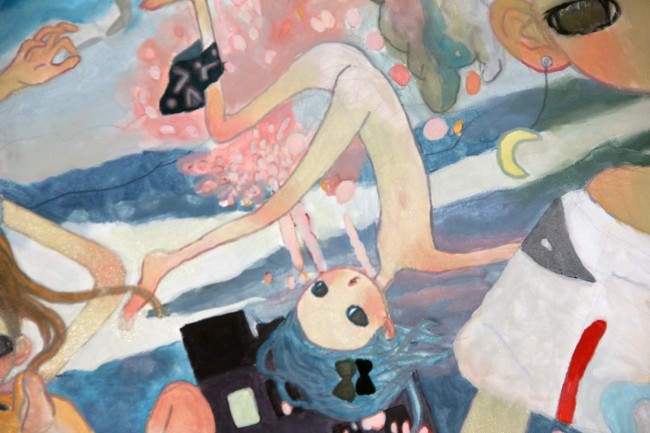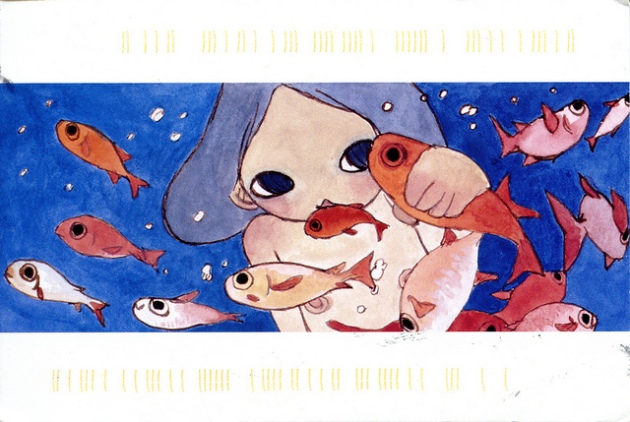 Chiho Aoshima is an artist more commonly talked about here in the states, but still fairly young so there wasn’t as much research on her work! I wanted to talk about her just a little bit because I had the chance to see her work “City Glow” in person last year at the Minneapolis Institute of Art! It is a lovely piece of animation work that took up an entire room at the gallery and stuck with me for hours after watching it.
Chiho Aoshima is an artist more commonly talked about here in the states, but still fairly young so there wasn’t as much research on her work! I wanted to talk about her just a little bit because I had the chance to see her work “City Glow” in person last year at the Minneapolis Institute of Art! It is a lovely piece of animation work that took up an entire room at the gallery and stuck with me for hours after watching it.
Here Goes: Chiho Aoshima was born in Tokyo, Japan in the year 1974 and received no formal artistic training. Despite her lack of formal training her hauntingly beautiful murals of glowing cities, enchanted forests, and ghostly schoolgirls attracted the attention of Superflat inventor Takahashi Murakami and she became one of his collection of young artists called the KaiKai Kiki Co. Like Takano, and most artists associated with the Superflat movement young girls take a leading part in Aoshima’s work. Unlike the artists Aya Takano and Nara however is Aoshima’s focus on modernity and landscape. Where Aya Takano seems to be making a statement about the sexualization of our youth Aoshima’s piece City Glow has other goals in mind. In the animaiton (or large prints than can be seen in the New York Subway System) a story unfolds that tells the life of a modern city in balance with the powerful paradise that surrounds it. By day the paradise rules and fairies, plants and ghoul like girls dance around the scenery. Eventually however these figures become replaced by tall phallic skyscrapers and glowing lights. The skyscrapers however do not loose their humanity, and keep the forms and faces of her ghostly female figures. As the city grows the paradise begins to fade and the fairies disappear. At this point one could guess that the piece was a statement about modernity crushing the natural paradise around it, but the video takes another turn. As a storm errupts and the scene is filled with rain and an eerie underwater scene the paradise begins to regrow. The building like figures eventually move around in a more organic manner and join in the paradises’ natural beauty. As nighttime comes again the paradise is twisted into a nightmarish scene of ghosts, demons and decapitated heads only to become the same paradise in the morning.
So what is Aoshima saying? Is it a statement about Modernity destroying the natural world? I don’t think so. Keep in mind that I am only an undergraduate student, and speak with absolutely no authority on the subject, but I would like to offer an interpretation of my own. One of the key elements binding the work of the Kaikai Kiki Co. is their belief that the different cultures of Japan and different scopes of art aren’t really so different at all. Although scholars can argue to high heaven that Michelangelo is art and Superman is just commercialism these artists don’t see the world in as black and white terms. Japan has a history of blurring the lines between “fine art” and “low art” that can be clearly observed in the celebration of the Ukiyo subculture of the 16th – 19th century. I wont go too into depth on the work of Ukiyo-e here, as the fascinating subject deserves it’s own post, but it essentially was a massive movement of artists depicting the life of people within one subculture. The subculture at hand was the “floating world” or the red-light district of Edo Japan. These scenes often depicted scenes from popular plays, beautiful women, every day life, and sexual scenes of courtesan’s and their patrons as well as young lovers “in the act”. According to the scholar Tetsuya Ozaki the word for “fine art” (bijitsu) in Japan wasn’t even created until the later Meiji Period (around 1873) after a flood of western influence. In his book entitled Superflat Takahashi Murakami says that he considers the words used for fine art (bijitsu) and the word for low art (geijitsu) to be too similar to be differentiated, and that he wishes to use then interchangeably. So we must return to the work “City Glow” by Chiho Aoshima. Her piece shows a wide variety of pictures from the same scene. We are treated to the overgrown paradise, the booming cityscape, the underwater fantasy, and the ghoul infested horror zone. But these scenes are all the same picture. Hopefully my point is becoming clear now. Aoshima is flattening the different cultures and flattening the different times and worlds within her city. There is no longer a barrier between the modern city and the overgrown paradise because they have become one within her work. Likewise Japan is no longer made up of past and present, bijitsu and geijitsu, or subculture and art. They are all one and CAN exist in harmony.
I could have her all wrong, maybe this piece is about the decapitation of femenism in a male dominated society, I don’t know, but that’s the great thing about Chiho Aoshima’s piece, it’s up to you to decide what to take from it.




